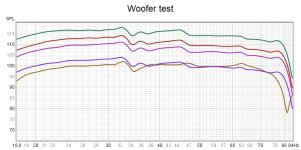1500€ worth of woofers for a small monitor speaker that appears to be well built and measures ok, but apparently still sounds harsh
(Perhaps the 3rd order HD creeping in?) 😉

(Perhaps the 3rd order HD creeping in?) 😉
Often, Charles, far too often.Compared to that how often did you experience quite the contrary ? Especially orchestral music does very often not sound very lifelike and quite unconvincing and unnerving even on very expensive systems.
Regards
Charles
There's a reason why heavy orchestral music is rarely, if ever, played at shows.
I'd say it's a step in the right direction.So all the distortion datas Klippel shows us is not that distortion (or lack of) what you are talking about? We still can't measure why a big ol' speaker still better than a nowadays small speaker? Simply by the old ones makes more dB/W with light (low Mms) drivers and utilizes larger boxes? That's all we need then for a lifelike sound?
So Purifi is not in the right direction with their drivers in general? Even their dedicated midrange drivers have higher moving mass than a typical midwoofer of the same size.I'd say it's a step in the right direction.
No, I wouldn't say that.
It depends on your objectives.
But for midrange only I'd pick this one (Bl: 6.23, Mms: 9g):

It depends on your objectives.
But for midrange only I'd pick this one (Bl: 6.23, Mms: 9g):
Last edited:
What is Re and what is Sd for this driver? And what driver is this?But for midrange only I'd pick this one (Bl: 6.23, Mms: 9g):
Btw my actual midrange choice have Bl = 11.7, Mms = 8.6g
Last edited:
Belive very many things are involved in this "matter"So saying that a lower Mms combined with more motor force leads to lower distortion does not seem to be a well-established rule.
15 years ago i had a Norwegian hifi friend wisiting, and we spend a few days comparing amplifiers.
My reference speaker in the test was Von Schweikert VR-4 upgraded to VR 5-7.
Amp we tested was Mcintosh MC 602 att 2 x 600W 2//4/8/ ohm, Krell FPB-450mcx monos att 2 x 450W class A 8 ohm, Krell Evolution F.B.I an integrated 2 x 300w 8ohm class A and a Pass Labs x350 at 2 x 350 w 8 ohm leaving first 25 watt in class A.
Von Schweikert VR-4 upgraded to VR 5-7 had 2 x 8,5 inch Seas Prestige H1208 L22RN4X/P in each speaker, working in their own 40 liter ported "enclosure".
Seas Prestige H1208 L22RN4X/P has a Mms of 40 grams and QTS at 0,27 with Force factor 10,7 N/A
All of the amps played with very very "top notch sound", and was quite "forgiving" in different recordings.
Pass Labs X350 had the most appealing midrange "qualities" like a really good tubeamp, but fail to have totalcontroll of the woofercones micromovements at high levels 100-108 dB, losing to much quality in reproducing 20-200 hz.
The Mcintosh was also fantastic at reproducing midrange frequencies, but also the Mcintosh fail to have totalcontroll of the woofercones micromovements at high levels 100-108 dB, losing to much quality in reproducing 20-200 hz.
Both Krell amps on the contrary, did manage to have total control of the woofercones movements, also micromovements at real high levels 110-115 dB
And the Krells midrange are also superb (and probably more "correct"), so winner was the Krell monos.
Now a detail to keep in mind:
Krell FPB-450mcx monos have a 3 kVA toroidal transformer.
Krell Evolution F.B.I an integrated have a 2,7 kVA toroidal transformer.
Pass Labs x350 have a 1,8 kVA toroidal transformer.
Mcintosh MC 602 a 1.5 kVA toroidal transformer.
Go figure?
Current is involved!
Let's consider this. The "stage" is what, guesstimate 15 by 8 meters. The "room" say 6 by 4.5 meters (20'x15'). So the "soundstage image" has to extend out beyond the walls by a lot, another 100% in each direction; image projections must be focused (however loosely) beyond the speakers by a far greater distance than to the listener. This doesn't inspire hope -- but I have actually heard such effect, sort of, depth at least 7.5 meters.Especially orchestral music does very often not sound very lifelike and quite unconvincing and unnerving even on very expensive systems.
Ha! (mods don't lounge this yet)
After dozens of diy experiments under a wide range of (domestic) conditions and speaker/listener placements (including height), I'm reasonably convinced by the empirical evidence and common-sense inference to state a theory of soundstage imaging depth. Bits had been posted over time to the Full Range Photo Gallery and various threads such as on-going "ragged coaxials".
Metaphysics or psycho-acoustics -- a progression?
Claim 1: It is the monophonic recording-through-to-playback-chain that is responsible for enabling soundstage depth perception; the...
After dozens of diy experiments under a wide range of (domestic) conditions and speaker/listener placements (including height), I'm reasonably convinced by the empirical evidence and common-sense inference to state a theory of soundstage imaging depth. Bits had been posted over time to the Full Range Photo Gallery and various threads such as on-going "ragged coaxials".
Metaphysics or psycho-acoustics -- a progression?
Claim 1: It is the monophonic recording-through-to-playback-chain that is responsible for enabling soundstage depth perception; the...
Belive very many things are involved in this "matter"
15 years ago i had a Norwegian hifi friend wisiting, and we spend a few days comparing amplifiers.
My reference speaker in the test was Von Schweikert VR-4 upgraded to VR 5-7.
Amp we tested was Mcintosh MC 602 att 2 x 600W 2//4/8/ ohm, Krell FPB-450mcx monos att 2 x 450W class A 8 ohm, Krell Evolution F.B.I an integrated 2 x 300w 8ohm class A and a Pass Labs x350 at 2 x 350 w 8 ohm leaving first 25 watt in class A.
Von Schweikert VR-4 upgraded to VR 5-7 had 2 x 8,5 inch Seas Prestige H1208 L22RN4X/P in each speaker, working in their own 40 liter ported "enclosure".
Seas Prestige H1208 L22RN4X/P has a Mms of 40 grams and QTS at 0,27 with Force factor 10,7 N/A
All of the amps played with very very "top notch sound", and was quite "forgiving" in different recordings.
Pass Labs X350 had the most appealing midrange "qualities" like a really good tubeamp, but fail to have totalcontroll of the woofercones micromovements at high levels 100-108 dB, losing to much quality in reproducing 20-200 hz.
The Mcintosh was also fantastic at reproducing midrange frequencies, but also the Mcintosh fail to have totalcontroll of the woofercones micromovements at high levels 100-108 dB, losing to much quality in reproducing 20-200 hz.
Both Krell amps on the contrary, did manage to have total control of the woofercones movements, also micromovements at real high levels 110-115 dB
And the Krells midrange are also superb (and probably more "correct"), so winner was the Krell monos.
Now a detail to keep in mind:
Krell FPB-450mcx monos have a 3 kVA toroidal transformer.
Krell Evolution F.B.I an integrated have a 2,7 kVA toroidal transformer.
Pass Labs x350 have a 1,8 kVA toroidal transformer.
Mcintosh MC 602 a 1.5 kVA toroidal transformer.
Go figure?
Current is involved!
This more or less matches my own experience.
I've listened to a lot of 'typical' hi-fi/high-end systems (Wilson-like), including those with Seas Prestige and Excel (magnesium with gold plug) drivers.
In the 90s I was quite impressed by, among other things, the large Avalons + Spectral electronics.
At the time I owned Dynaudio speakers and before that B&W, mostly with class A and A/B amps.
Currently I am still advising an old friend who bought Rosso Fiorentino speakers, a big Pathos amplifier and more recently (on my recommendation) an EAR phono box.
By the way, the latest model from Rosso Fiorentino includes modified Sica woofers, similar to the ones mentioned earlier.
One of my wake-up calls was a demo of the then new Dynaudio Evidence Master with top of the line class Classé, Levinson and Krell amplifiers.
Also present was a professional violinist from the National Symphonic Orchestra. We both agreed that this +200k setup failed miserably at conveying the musical message, let alone creating a believable psychoacoustic illusion.
I could go on forever about similar experiences/examples.
I'm going to summarize it using my buddy, who also listens to music while working from home.
He (unconsciously) prefers the typical hi-fi reproduction, which my brother and I usually refer to as the sound of 'grandma's improved kitchen radio'.
It sounds pleasant, but does not actively involve you in the music and definitely does not suck you in.
In short, what are the determining factors of this 'signature'?
Complexity, damping <> efficiency/sensitivity.
Last edited:
By the way, the latest model from Rosso Fiorentino includes modified Sica woofers, similar to the ones mentioned earlier.
Francesco Rubenni, the designer of Rosso Fiorentino (an acoustician) also seems to recognize the importance of efficiency/sensitivity (+ load), because he increasingly uses these terms as an argument in his interviews and marketing.
Last edited:
Let's consider this. The "stage" is what, guesstimate 15 by 8 meters. The "room" say 6 by 4.5 meters (20'x15'). So the "soundstage image" has to extend out beyond the walls by a lot, another 100% in each direction; image projections must be focused (however loosely) beyond the speakers by a far greater distance than to the listener. This doesn't inspire hope -- but I have actually heard such effect, sort of, depth at least 7.5 meters.
Ha! (mods don't lounge this yet)
After dozens of diy experiments under a wide range of (domestic) conditions and speaker/listener placements (including height), I'm reasonably convinced by the empirical evidence and common-sense inference to state a theory of soundstage imaging depth. Bits had been posted over time to the Full Range Photo Gallery and various threads such as on-going "ragged coaxials".
Metaphysics or psycho-acoustics -- a progression?
Claim 1: It is the monophonic recording-through-to-playback-chain that is responsible for enabling soundstage depth perception; the...
I don't tink it's possible to reproduce a large orchestra in an average or even large room to scale, but one may approximate the illusion.
What is needed? Multiple cones (an array seems appropriate) and a matching mid/high section.
A virtual, vertical, slightly asymmetrically aligned point source.
I'm currently working on a similar concept.
Last edited:
Anyone who has ever heard a WE Mirrophonic or a GIP 9700 will remember the almost terrifying sensitivity.
The misleading term 'transparency' then takes almost physical shape.
However, such systems often sound somewhat thin > hardly any sub bass and relatively much mid/high energy.
That's one reason why vintage freaks using such systems play almost exclusively vocal and similar (what we call) 'tingel tangel' music.
My brother and I use our own terminology (refined over the years) to indicate (combined) underlying electroacoustic aspects/phenomena.
One of these - which is sometimes also used by more developed/knowledgable reviewers - is 'body' (we also refer to this as 'blood flow').
To summarize simply and incompletely: 'body' is what a very good dedicated cone midrange section adds compared to some comp. driver + horn combinations that are used from 500 Hz or below.
This is not/less applicable to Camplo's Axi 2050s, because its diaphragm is just as large as a cone midrange.
But the 'body' aspect also concerns 'scale' > namely the illusion of the dimensions (energy cues) of (within) a certain venue, studio, etc.
IMD, among other things, is an important aspect.
Especially with complex pieces of music, such as the well-known works of Lutoslawski, Shostakovich, Schnittke, Stravinsky and others,
most hi-fi/high-end systems fail miserably.
Spreading the load is central to all of this.
The misleading term 'transparency' then takes almost physical shape.
However, such systems often sound somewhat thin > hardly any sub bass and relatively much mid/high energy.
That's one reason why vintage freaks using such systems play almost exclusively vocal and similar (what we call) 'tingel tangel' music.
My brother and I use our own terminology (refined over the years) to indicate (combined) underlying electroacoustic aspects/phenomena.
One of these - which is sometimes also used by more developed/knowledgable reviewers - is 'body' (we also refer to this as 'blood flow').
To summarize simply and incompletely: 'body' is what a very good dedicated cone midrange section adds compared to some comp. driver + horn combinations that are used from 500 Hz or below.
This is not/less applicable to Camplo's Axi 2050s, because its diaphragm is just as large as a cone midrange.
But the 'body' aspect also concerns 'scale' > namely the illusion of the dimensions (energy cues) of (within) a certain venue, studio, etc.
IMD, among other things, is an important aspect.
Especially with complex pieces of music, such as the well-known works of Lutoslawski, Shostakovich, Schnittke, Stravinsky and others,
most hi-fi/high-end systems fail miserably.
Spreading the load is central to all of this.
Last edited:
I recently bought 20 of these, to build a linesourse.I'd choose this driver for (alternative) hi-fi 3-way systems > higher than average sensitivity and simple crossovers.
Half price on sale 8-9 euro a piece 😊
I actually have it in my sound room in the basement!I don't tink it's possible to reproduce a large orchestra in an average or even large room to scale, but one may approximate the illusion.
But it needed a lot of diaphragm surface & 100 dB sensitivity.
6 longtrow 12 inch woofer, 4 Audax 8 inch midranges and 2 very exensive Mundorf AMT tweeters.
In a good damped rum 5 by 10,5 meters airtight. (and much power to them)
Don´t have good photos on just them (you know diyérs, always "on the run")Jawen, would you mind to share some pics.?
But this was the concept, and how it "in the end" had to be. (after had blow 5-6 Audax 5,25 inch midranges)
215 kilo each
Woofers in ca 105 liter netto ported up to ca 340 hz active filter, MTM everyting over 340 hz from active filter with a passive filter at 1850 hz to AMT.
Ask questions if you like
regards John
Attachments
-
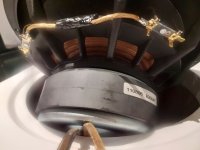 20210806_124400.jpg430.6 KB · Views: 100
20210806_124400.jpg430.6 KB · Views: 100 -
 20210806_144632.jpg375.1 KB · Views: 99
20210806_144632.jpg375.1 KB · Views: 99 -
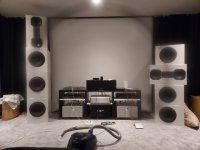 20210806_144742.jpg333.1 KB · Views: 98
20210806_144742.jpg333.1 KB · Views: 98 -
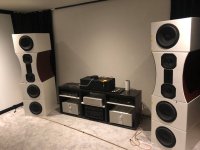 240592069_2056621821153419_9218351492205500293_n.jpg274.4 KB · Views: 84
240592069_2056621821153419_9218351492205500293_n.jpg274.4 KB · Views: 84 -
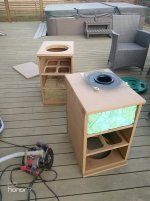 IMG_20210723_213829.jpg442.9 KB · Views: 87
IMG_20210723_213829.jpg442.9 KB · Views: 87 -
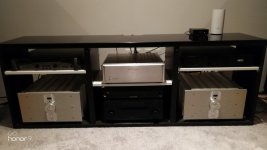 IMG_20211007_145941.jpg210.4 KB · Views: 89
IMG_20211007_145941.jpg210.4 KB · Views: 89 -
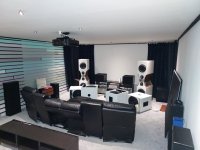 20210126_155428.jpg411.1 KB · Views: 89
20210126_155428.jpg411.1 KB · Views: 89 -
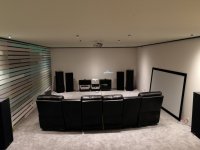 IMG_20180310_193933.jpg273.1 KB · Views: 100
IMG_20180310_193933.jpg273.1 KB · Views: 100 -
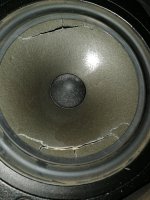 2.jpg771 KB · Views: 100
2.jpg771 KB · Views: 100 -
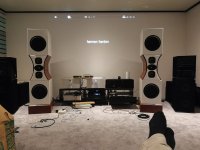 IMG_20200909_181709.jpg362 KB · Views: 105
IMG_20200909_181709.jpg362 KB · Views: 105 -
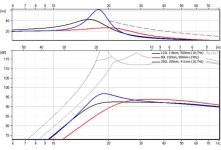 Peerless830847-1.jpg33.4 KB · Views: 104
Peerless830847-1.jpg33.4 KB · Views: 104
It´s 6 Peerlees 830847. (Sadly Peerlees don´t sell them sinse 2007-08)Can you be more specific?
FS is 21,8 hz, QTS is 0,36, VAS 144,2, BL 10,2 Tm, Mms 110,9 gram, Cms 0,48
AND incedible 92 dB in sensivty an a linjear xmax +-12,5 mm.
Driver have dubble 8 ohm 51 mm coils, connected in series to 16 ohm, and i have 3 per side in parallel outside the box to 5,66 ohm.
Mounted in 25 mm MDF box (baffle 50 mm) reinforced/staged, port 102 mm inside 33 cm long (if my memory is right) Filling is stonewool by ca 30% of internal space wrapt in textile to not get dust from it in the lungs.
Driven by a Krell f.b.i stereo amp intg (that Stereophile measured to 2 X 430 W/8 ohm), one channel per side, so ca 225 Watt each in 6 ohm
Plays flat to 20 hz around 120 dB, port give much to 15 hz.
Ask more if i missed something 👍
Attachments
- Home
- Loudspeakers
- Multi-Way
- Is it possible to cover the whole spectrum, high SPL, low distortion with a 2-way?
